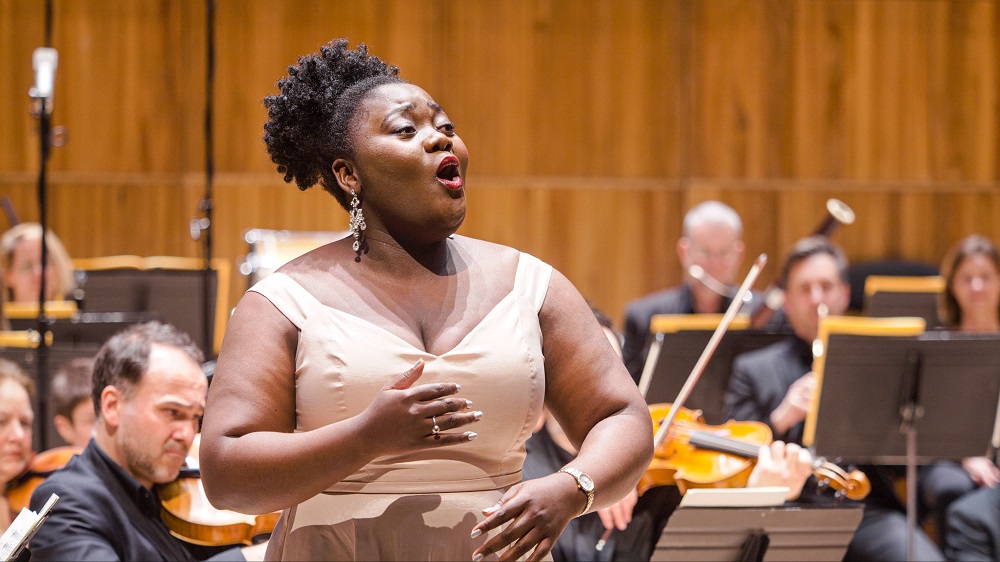Mahler on modern instruments is ubiquitous these days, so historically informed performance is bound to be revealing. Here, the Orchestra of the Age of Enlightenment brought transparency and focus to Mahler’s often complex textures in his Fourth Symphony. The concert was programmed as a showcase for young South African soprano Masabane Cecilia Rangwanasha, whose voice is ideal for this repertoire. But just as interesting was conductor Ádám Fischer, an engaged and energetic Mahlerian, and always gently resistant to convention.
The concert opened with the Adagietto from Mahler’s Fifth. The gut strings afforded a rich and satisfying tone, especially when the melody moved down to the violas. Fischer led a brisk account, but his tempos were always fluid. Phrases were clearly defined, and balances within the ensemble carefully judged. At the climax, he seemed to be expecting more weight from the basses, but this orchestra was smaller than either he or Mahler would usually command.
Three songs followed, settings of texts from Des Knaben Wunderhorn. Masabane Cecilia Rangwanasha (pictured below) is making a career in opera, and she brought an operatic sensibility to Mahler’s vocal lines. Her voice has a rich, distinctive tone, which she retains up into the higher register. She also has a luxuriant but well controlled vibrato, narrow but not too fast. But she lacks power, and Fischer clearly struggled to balance the orchestra against her, even with period instruments. Her rich tone also comes at the expense of legible words, which was particularly frustrating as the OAE did not provide texts, either in the programme or as surtitles. Nevertheless, Rangwanasha was suitably playful and naïve for ‘Wer hat dies Liedlein erdacht’ and ‘Rheinlegendchen’, and added a touch of gravitas for ‘Wo die schönen Trompeten blasen’. The main asset from the orchestra were the woodwind soloists, whose woody narrow-bore sound mixed playfully with Rangwanasha’s voice.  The second half began with an announcement from the podium. Ádám Fischer made a short speech from the podium (pictured below) about the plight of Ukraine. He recalled when he was a child in Budapest, sheltering while the Soviet tanks rolled in following the Hungarian uprising. There followed an impromptu performance of Air on a G-String, an elegant rendition, wholly devoid of sentimentality.
The second half began with an announcement from the podium. Ádám Fischer made a short speech from the podium (pictured below) about the plight of Ukraine. He recalled when he was a child in Budapest, sheltering while the Soviet tanks rolled in following the Hungarian uprising. There followed an impromptu performance of Air on a G-String, an elegant rendition, wholly devoid of sentimentality.
Ádám Fischer is a seasoned but overlooked Mahlerian. He has recently released a cycle of Mahler symphonies with his Dusseldorf orchestra, but these are destined to be overshadowed by the earlier set from his older brother, Iván, with the Budapest Festival Orchestra. But the consensus of critical opinion is that Ádám’s Mahler is more radical and distinctive than Iván’s. Ádám’s ideas don’t always work, but he always offers a new perspective. Onstage, he is a jittery and nervous presence. His movements are small and frenetic, and he conducts every beat. He clearly values control, but his tempos are so fluid and natural that the results rarely sound staid. Tempos are faster than average, but often change suddenly, even mid-phrase. And phrases are always cleanly defined, with Fischer showing an impressive mastery of the details of each score, performing the entire concert from memory.  In the first movement of this Fourth, the woodwinds again excelled. The period contrabassoon was a nice touch, more nasal than its modern descendent, and highlighted here. The second movement should be a solo for the leader of the orchestra playing on a retuned violin. Matthew Truscott gave a lively reading, though he was overshadowed by the first horn, Gavin Edwards. He has an important solo part as well, but not to the extent that the balances suggested. Montgomery played elegantly though, his Vienna horn producing a slight edge, but never a rasp.
In the first movement of this Fourth, the woodwinds again excelled. The period contrabassoon was a nice touch, more nasal than its modern descendent, and highlighted here. The second movement should be a solo for the leader of the orchestra playing on a retuned violin. Matthew Truscott gave a lively reading, though he was overshadowed by the first horn, Gavin Edwards. He has an important solo part as well, but not to the extent that the balances suggested. Montgomery played elegantly though, his Vienna horn producing a slight edge, but never a rasp.
Fischer opened the third movement at a brisk pace, well suited to the strings’ efficient, minimal vibrato. The movement soon moves to more turbulent and dramatic music, and Fischer choreographed this beautifully. But again it seemed that he was looking for a broader sound than this modestly sized ensemble could offer, and the climax was spoiled by ragged playing from the brass.
Rangwanasha gave another passionate reading in her fourth movement solo. Balance was less of a problem here, even though she was standing at the back of the stage. Fischer’s tempos remained fluid and unpredictable, and Rangwanasha did well to follow his sudden accelerandos mid-way through several of her phrases. The fruity sound of the period clarinet (Katherine Spencer) was the defining sonority here, but the distinctive string sound was also a real asset in the quiet coda, as Fischer finally relinquished his tight grip and allowed the music to gradually dissipate.














Add comment